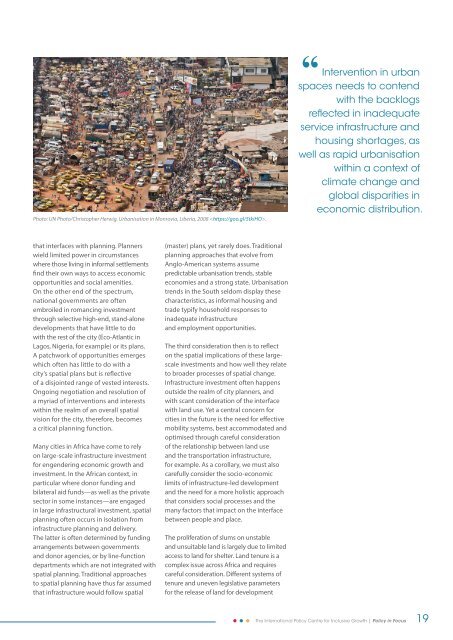A new urban paradigm pathways to sustainable development
PiF37
PiF37
Create successful ePaper yourself
Turn your PDF publications into a flip-book with our unique Google optimized e-Paper software.
Pho<strong>to</strong>: UN Pho<strong>to</strong>/Chris<strong>to</strong>pher Herwig. Urbanisation in Monrovia, Liberia, 2008 .<br />
“<br />
Intervention in <strong>urban</strong><br />
spaces needs <strong>to</strong> contend<br />
with the backlogs<br />
reflected in inadequate<br />
service infrastructure and<br />
housing shortages, as<br />
well as rapid <strong>urban</strong>isation<br />
within a context of<br />
climate change and<br />
global disparities in<br />
economic distribution.<br />
that interfaces with planning. Planners<br />
wield limited power in circumstances<br />
where those living in informal settlements<br />
find their own ways <strong>to</strong> access economic<br />
opportunities and social amenities.<br />
On the other end of the spectrum,<br />
national governments are often<br />
embroiled in romancing investment<br />
through selective high-end, stand-alone<br />
<strong>development</strong>s that have little <strong>to</strong> do<br />
with the rest of the city (Eco-Atlantic in<br />
Lagos, Nigeria, for example) or its plans.<br />
A patchwork of opportunities emerges<br />
which often has little <strong>to</strong> do with a<br />
city’s spatial plans but is reflective<br />
of a disjointed range of vested interests.<br />
Ongoing negotiation and resolution of<br />
a myriad of interventions and interests<br />
within the realm of an overall spatial<br />
vision for the city, therefore, becomes<br />
a critical planning function.<br />
Many cities in Africa have come <strong>to</strong> rely<br />
on large-scale infrastructure investment<br />
for engendering economic growth and<br />
investment. In the African context, in<br />
particular where donor funding and<br />
bilateral aid funds—as well as the private<br />
sec<strong>to</strong>r in some instances—are engaged<br />
in large infrastructural investment, spatial<br />
planning often occurs in isolation from<br />
infrastructure planning and delivery.<br />
The latter is often determined by funding<br />
arrangements between governments<br />
and donor agencies, or by line-function<br />
departments which are not integrated with<br />
spatial planning. Traditional approaches<br />
<strong>to</strong> spatial planning have thus far assumed<br />
that infrastructure would follow spatial<br />
(master) plans, yet rarely does. Traditional<br />
planning approaches that evolve from<br />
Anglo-American systems assume<br />
predictable <strong>urban</strong>isation trends, stable<br />
economies and a strong state. Urbanisation<br />
trends in the South seldom display these<br />
characteristics, as informal housing and<br />
trade typify household responses <strong>to</strong><br />
inadequate infrastructure<br />
and employment opportunities.<br />
The third consideration then is <strong>to</strong> reflect<br />
on the spatial implications of these largescale<br />
investments and how well they relate<br />
<strong>to</strong> broader processes of spatial change.<br />
Infrastructure investment often happens<br />
outside the realm of city planners, and<br />
with scant consideration of the interface<br />
with land use. Yet a central concern for<br />
cities in the future is the need for effective<br />
mobility systems, best accommodated and<br />
optimised through careful consideration<br />
of the relationship between land use<br />
and the transportation infrastructure,<br />
for example. As a corollary, we must also<br />
carefully consider the socio-economic<br />
limits of infrastructure-led <strong>development</strong><br />
and the need for a more holistic approach<br />
that considers social processes and the<br />
many fac<strong>to</strong>rs that impact on the interface<br />
between people and place.<br />
The proliferation of slums on unstable<br />
and unsuitable land is largely due <strong>to</strong> limited<br />
access <strong>to</strong> land for shelter. Land tenure is a<br />
complex issue across Africa and requires<br />
careful consideration. Different systems of<br />
tenure and uneven legislative parameters<br />
for the release of land for <strong>development</strong><br />
The International Policy Centre for Inclusive Growth | Policy in Focus 19


